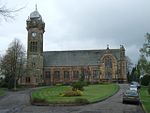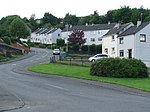Kilmacolm ( ) is a village and civil parish in the Inverclyde council area, and the historic county of Renfrewshire in the west central Lowlands of Scotland. It lies on the northern slope of the Gryffe Valley, 7+1⁄2 miles (12 kilometres) southeast of Greenock and around 15 miles (24 km) west of the city of Glasgow. The village has a population of around 4,000 and is part of a wider civil parish which covers a large rural hinterland of 15,000 hectares (150 km2; 58 sq mi) containing within it the smaller settlement of Quarrier's Village, originally established as a 19th-century residential orphans' home.
The area surrounding the village was settled in prehistoric times and emerged as part of a feudal society with the parish divided between separate estates for much of its history. The village itself remained small, providing services to nearby farm communities and acting as a religious hub for the parish. The name of the village derives from the Scottish Gaelic Cill MoCholuim, indicating the dedication of its church to St Columba. The parish church was mentioned in a papal bull of 1225 showing its appropriation to Paisley Abbey, and it sits on the site of an ancient religious community dating to the 5th or 6th centuries. Again in the 13th century, Duchal Castle was constructed in the parish and is notable for being besieged by King James IV of Scotland in 1489, following the resident Lyle family's support of an insurrection against him. Feuding between the noble families of Kilmacolm was commonplace in the Middle Ages, and in the 16th and 17th centuries, the parish again came to the attention of the Crown for providing support to outlawed religious Covenanters.
The character of the village changed significantly in the Victorian era, with the arrival of the railway in Kilmacolm in 1869. Many of Kilmacolm's modern buildings were constructed between this date and the outbreak of World War I. The emergence of such transport links enabled the village to expand as an affluent dormitory village serving the nearby urban centres of Glasgow, Paisley and Greenock. The economy of the village reflected this population change, moving away from its traditional reliance on agriculture to providing tertiary sector services to residents and visitors.








